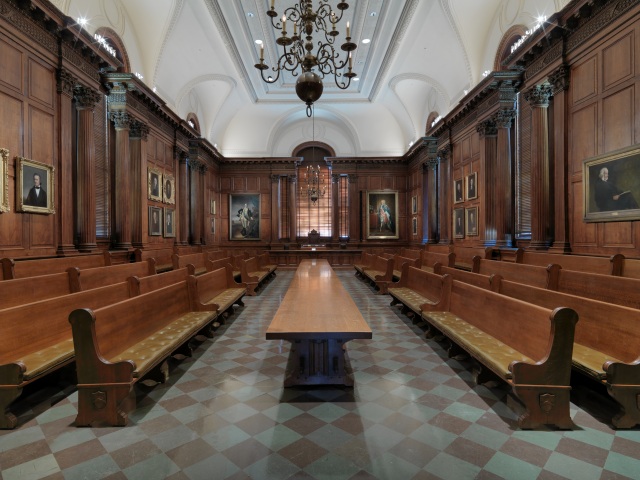Nassau Hall, Princeton University
Explore the Faculty Room
Expert Voice: Dan Linke (University Archivist)
At the time of its construction in 1756, Nassau Hall, 176 feet long and fifty-four feet wide, was the largest academic building in the American colonies. During the course of its over 250-year existence, “Old Nassau” has housed every college function: classrooms, student rooms, administrators’ offices, library, chapel, labs, museum, kitchen, and cafeteria. It also has served some unusual purposes: barracks for both British and American soldiers during the Revolutionary War; a battleground during the Battle of Princeton on January 3, 1777; and, later, for five months in 1783, temporary home of the Continental Congress. It was here, when Princeton served as the nation’s capitol, that Congress first learned the British had signed a peace treaty and the United States gained its independence. Primarily for these reasons, it is a national landmark.

Designed by Dr. William Shippen and Robert Smith of Philadelphia, the Trustees originally requested that it be constructed from brick but later decided to build it out of a light brown sandstone from a nearby quarry, the remnants of which can be seen as one drives down Washington Road toward Lake Carnegie. This choice was a fortuitous one, as the building would be ravaged by two fires, one in 1802 and another in 1855, and the building’s thick walls—exceeding fourteen inches at its base—survived both and allowed for reconstruction.
Upon entering the front door of the building, visitors will find themselves in the Memorial Atrium, constructed in 1920 to honor the alumni who died while serving in the nation’s military during wartime. This is the same room that Bob Dylan referred to as a tomb in his song “Day of the Locusts,” a musical recounting of the day he received a Princeton honorary degree in 1970.
Gregg Lange, Class of 1970, history columnist for Princeton Alumni Weekly talks about The Orange and the Black
As Princeton school spirit and intercollegiate athletics rapidly took form following the Civil War, Princeton’s class of 1869 chose orange badges for its freshman baseball team to wear against Yale, since William III of Nassau, after whom Nassau Hall was named, was also Prince of Orange. They used black ink to inscribe their class numerals, since that’s what they had. Within fifteen years, Princeton’s teams – especially the national power football team – were becoming known as Tigers by the press, in part because of their orange-and-black striped jerseys. The marriage of the colors and the mascot was cemented by undergraduate Clarence Mitchell of the Class of 1889 when he penned the ballad, still sung today, that ends this way:
We will own the lilies slender,
Nor honor shall they lack,
While the tiger stands defender
Of the Orange and the Black.
[sung or spoken]



*For its 1876 football game with Yale, Princeton's team proudly wore black jerseys with an orange “P” on the chest. When orange stripes appeared on the black jerseys, sleeves, and stockings in 1880, the nickname “Tigers” became part of the Princeton lexicon.
**On October 12, 1868, the faculty of the College of New Jersey (as Princeton University was then known) passed a resolution permitting students “to adopt and wear as the college badge an orange colored Ribbon bearing upon it the word Princeton.” Pictured here is a badge for Class of 1870.
